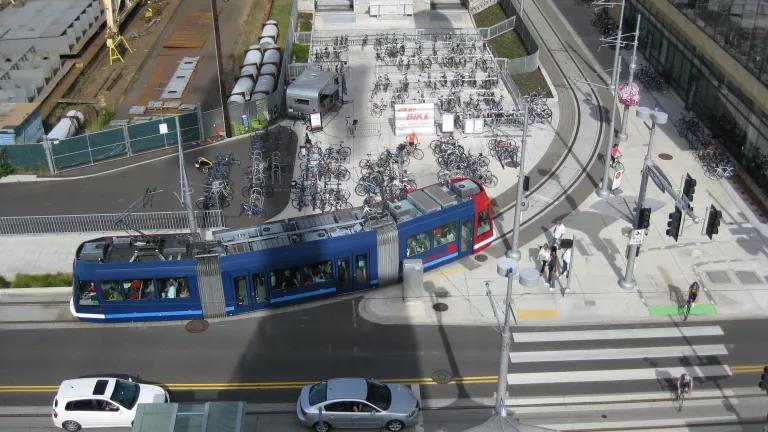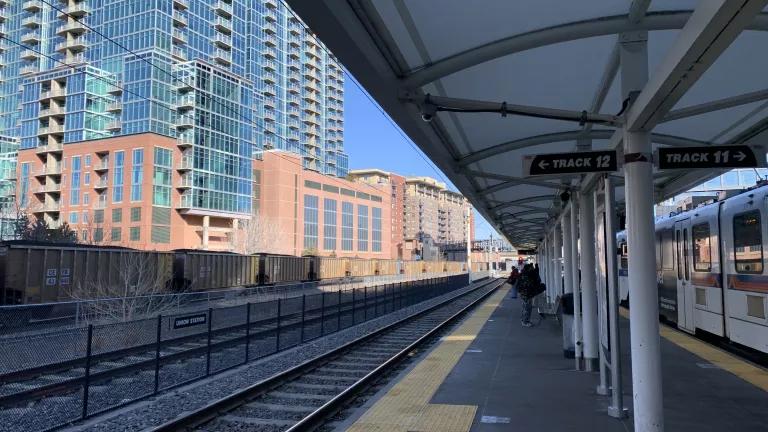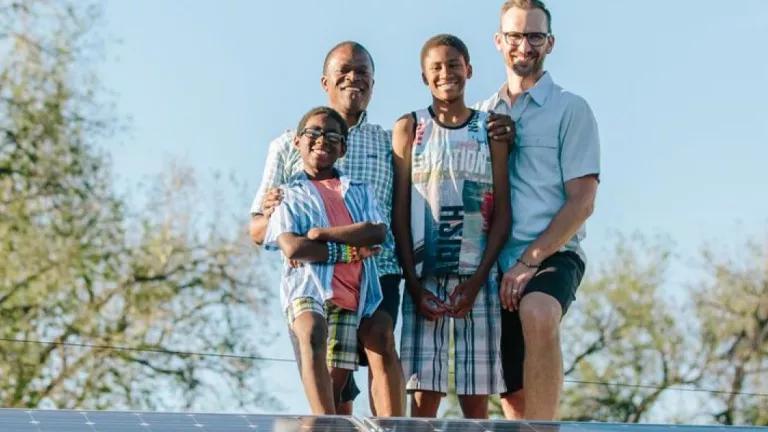Act Locally: How to Activate Bold Infrastructure Ideas
This guide identifies key strategies to use historic new resources to transition away from the failed policies of the past to a cleaner, more sustainable future

An overhead view of a MAX Light Rail train passing through a signal-separated bicycle crossing at the Moody Avenue intersection in Portland, Oregon.
City of Portland via NACTO, CC BY-NC 4.0
The Opportunity
With the Inflation Reduction Act (IRA) and the bipartisan infrastructure law, Congress and the Biden administration have put in place historic investments in the future of this country. These two measures are delivering unprecedented increases in federal infrastructure dollars, which will total nearly $3 trillion between now and 2026. We are at a unique moment in which to transition our nation to a cleaner, more sustainable future.
The Challenge
Much of the decision-making on how and where to distribute IRA and infrastructure funds is left to state governments. As a result, there is an urgent need for local leaders to understand the possibilities for how these funds can best be utilized. Absent local empowerment, these funds could be wasted on business-as-usual projects.
This would be a catastrophically wasted opportunity: Think wider highways, divided communities, dirty energy, and higher household utility bills.
An Investment Guide for Changemakers
The antidote to the failed policies of the past is found in listening to local leaders. This “Act Locally” resource was created to unleash the power of community-led solutions to reduce pollution, increase equity, and meaningfully improve the lives of people in cities, suburbs, tribal areas, and towns. These once-in-a-generation federal funds can help communities tackle the intertwined crisis of inequality and climate change.
Local officials and advocates are the primary audience for this guide, which includes key information about 46 federal funding streams and details on relevant state infrastructure policy and regulatory frameworks for all 50 states. Importantly, it highlights five key opportunities to deploy and combine funding in new ways to achieve local priorities that may not be on the radar of state officials.
We encourage local leaders to engage state decision-makers to:
- Deliver substantial support to deepen local capacity;
- Use federal transportation funds to support safer driving and enhanced walking, biking, public transit, and electric vehicle (EV) charging infrastructure;
- Ensure the benefits of vehicle electrification are widely shared;
- Maximize building decarbonization benefits, especially for communities that are underserved and primarily Black, indigenous and people of color;
- Invest in workforce training and support.

What Is Possible?
The report is full of specific examples of the possibilities that exist if new coalitions are built and if funding is invested innovatively. For example:
- Of the $239 billion appropriated for the four largest surface transportation formula programs, up to 50 percent can be “flexed” from roads to uses such as transit, walking, biking, safety, and electric vehicle infrastructure. And these funds can be redirected to bolster workforce training and desperately needed supportive services like childcare.
- Every $100 million redirected from building highways could pay for 90 new electric buses, or 200 miles of new sidewalks, or 751 miles of bike lanes, or 342 hours of bus service per day for five years. The graphic above illustrates the purchasing power of five states if they were to invest just half the growth in transportation formula funds toward acquiring new electric buses. (And there’s tons of room for improvement since, on average, states have flexed a paltry four percent of these funds to transit investments in the past.)
- Through IRA funding, some state energy offices could see their building decarbonization budgets increase as much as tenfold. This is a staggering level of growth, even for well-staffed agencies. Local leaders must take the initiative to engage these state offices and highlight community priorities and communicate best practices. This will ensure that IRA building decarbonization resources are invested in ways that equitably transform the built environment and improve the health and wealth of historically underserved communities.
- The amount of infrastructure jobs in the pipeline is staggering. Nationally, researchers predict a doubling of jobs related to transportation infrastructure, from 16.6 million jobs to 32 million between now and 2030, and even faster growth of jobs in renewable energy, from 8 million to 20 million during the same time frame. Eligible workforce investments now include travel to job sites and childcare expenses. The funding flexibility can remove barriers that women, individuals with disabilities, and people of color face when attempting to access promising careers and procurement opportunities in the infrastructure and energy sectors.
“Act Locally” also features detailed data from five “deep dive” states where NRDC has strong relationships: Colorado, Georgia, Illinois, North Carolina, and Pennsylvania. The data gathered from these places are illustrative of the kind of data local organizers can gather about their own communities, to assemble a compelling case for different funding priorities.

Joe DelNero/NREL, 80595
Use It or Lose It
This resource was specifically created to aid local advocates and local governments in accessing federal infrastructure funding and customizing bold plans to achieve multiple benefits from equitable investments. When local leaders engage with state decision makers around innovative deployment of these investments, the sky’s the limit. By tapping the ideas and data in “Act Locally”, advocates and local officials can confront environmental and racial injustices, center community wisdom, achieve climate gains, and unleash economic opportunity for all.




